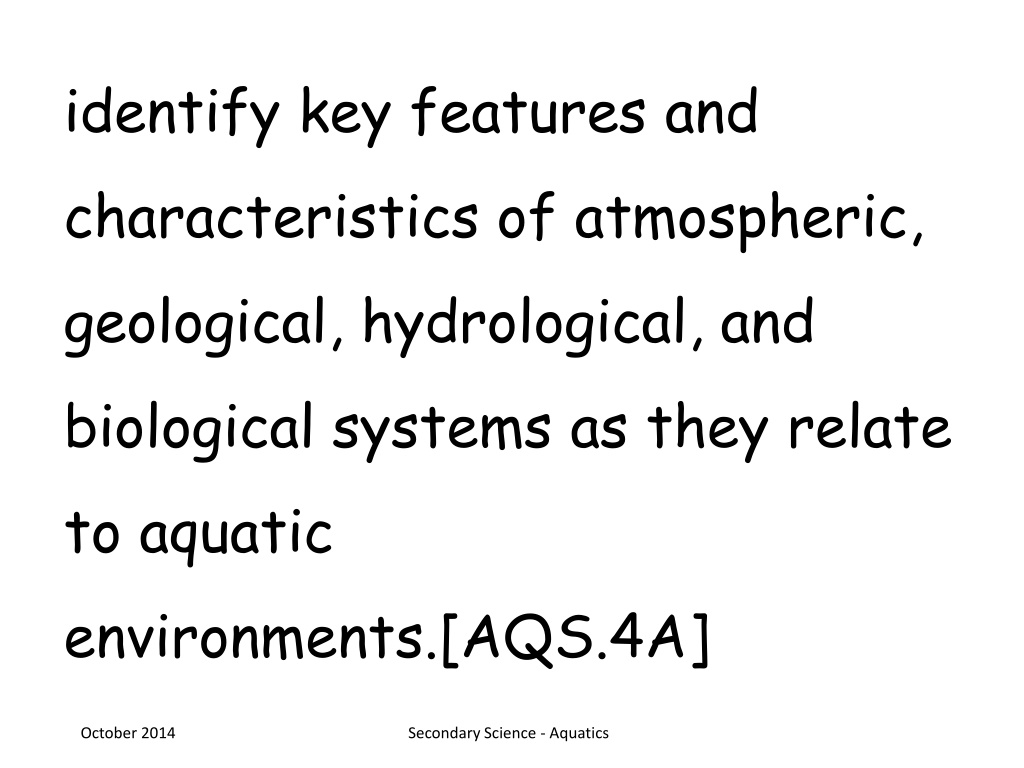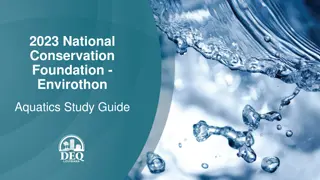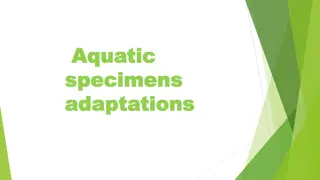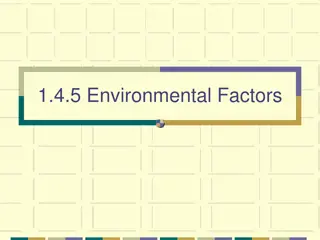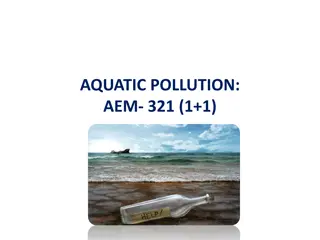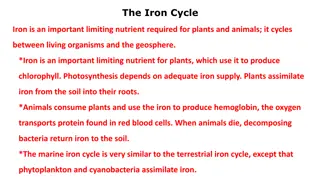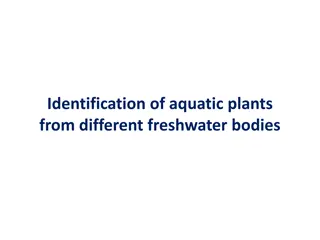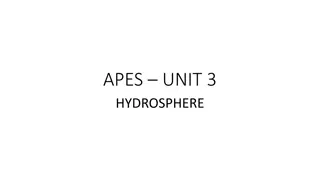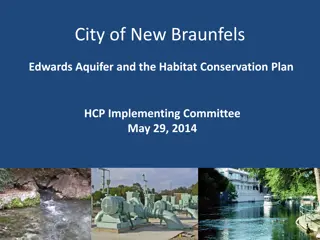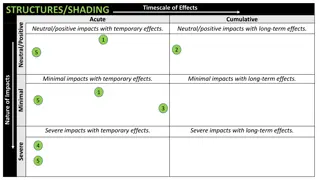Understanding Aquatic Environments: Systems and Interactions
Explore the key features and characteristics of atmospheric, geological, hydrological, and biological systems in relation to aquatic environments. Apply systems thinking to analyze positive and negative feedback cycles. Utilize technology to collect and evaluate global environmental data. Evaluate data over time, collect baseline quantitative data, and analyze interrelationships in local aquatic ecosystems. Identify interdependence of organisms and the role of carbon, nitrogen, water, and nutrient cycles in aquatic environments.
Download Presentation

Please find below an Image/Link to download the presentation.
The content on the website is provided AS IS for your information and personal use only. It may not be sold, licensed, or shared on other websites without obtaining consent from the author. Download presentation by click this link. If you encounter any issues during the download, it is possible that the publisher has removed the file from their server.
E N D
Presentation Transcript
identify key features and characteristics of atmospheric, geological, hydrological, and biological systems as they relate to aquatic environments.[AQS.4A] October 2014 Secondary Science - Aquatics
apply systems thinking to the examination of aquatic environments, including positive and negative feedback cycles.[AQS.4B] October 2014 Secondary Science - Aquatics
collect and evaluate global environmental data using technology such as maps, visualizations, satellite data, Global Positioning System (GPS), Geographic Information System (GIS), weather balloons, buoys, etc.[AQS.4C] October 2014 Secondary Science - Aquatics
evaluate data over a period of time from an established aquatic environment documenting seasonal changes and the behavior of organisms.[AQS.5A] October 2014 Secondary Science - Aquatics
collect baseline quantitative data, including pH, salinity, temperature, mineral content, nitrogen compounds, and turbidity from an aquatic environment.[AQS.5B] October 2014 Secondary Science - Aquatics
analyze interrelationships among producers, consumers, and decomposers in a local aquatic ecosystem.[AQS.5C] October 2014 Secondary Science - Aquatics
identify the interdependence of organisms in an aquatic environment such as in a pond, river, lake, ocean, or aquifer and the biosphere.[AQS.5D] October 2014 Secondary Science - Aquatics
identify the role of carbon, nitrogen, water, and nutrient cycles in an aquatic environment, including upwellings and turnovers.[AQS.6A] October 2014 Secondary Science - Aquatics
examine the interrelationships between aquatic systems and climate and weather, including El Ni?o and La Ni?a, currents, and hurricanes.[AQS.6B] October 2014 Secondary Science - Aquatics
identify sources and determine the amounts of water in a watershed, including rainfall, groundwater, and surface water.[AQS.7A] October 2014 Secondary Science - Aquatics
identify factors that contribute to how water flows through a watershed.[AQS.7B] October 2014 Secondary Science - Aquatics
identify water quantity and quality in a local watershed.[AQS.7C] October 2014 Secondary Science - Aquatics
demonstrate basic principles of fluid dynamics, including hydrostatic pressure, density, salinity, and buoyancy.[AQS.8A] October 2014 Secondary Science - Aquatics
identify interrelationships between ocean currents, climates, and geologic features.[AQS.8B] October 2014 Secondary Science - Aquatics
describe and explain fluid dynamics in an upwelling and lake turnover.[AQS.8C] October 2014 Secondary Science - Aquatics
differentiate among freshwater, brackish, and saltwater ecosystems.[AQS.9A] October 2014 Secondary Science - Aquatics
identify the major properties and components of different marine and freshwater life zones.[AQS.9B] October 2014 Secondary Science - Aquatics
identify biological, chemical, geological, and physical components of an aquatic life zone as they relate to the organisms in it.[AQS.9C] October 2014 Secondary Science - Aquatics
classify different aquatic organisms using tools such as dichotomous keys.[AQS.10A] October 2014 Secondary Science - Aquatics
compare and describe how adaptations allow an organism to exist within an aquatic environment.[AQS.10B] October 2014 Secondary Science - Aquatics
compare differences in adaptations of aquatic organisms to fresh water and marine environments.[AQS.10C] October 2014 Secondary Science - Aquatics
identify how energy flows and matter cycles through both fresh water and salt water aquatic systems, including food webs, chains, and pyramids.[AQS.11A] October 2014 Secondary Science - Aquatics
evaluate the factors affecting aquatic population cycles. [AQS.11B] October 2014 Secondary Science - Aquatics
predict effects of chemical, organic, physical, and thermal changes from humans on the living and nonliving components of an aquatic ecosystem. [AQS.12A] October 2014 Secondary Science - Aquatics
analyze the cumulative impact of human population growth on an aquatic system.[AQS.12B] October 2014 Secondary Science - Aquatics
investigate the role of humans in unbalanced systems such as invasive species, fish farming, cultural eutrophication, or red tides.[AQS.12C] October 2014 Secondary Science - Aquatics
analyze and discuss how human activities such as fishing, transportation, dams, and recreation influence aquatic environments.[AQS.12D] October 2014 Secondary Science - Aquatics
understand the impact of various laws and policies such as The Endangered Species Act, right of capture laws, or Clean Water Act on aquatic systems.[AQS.12E] October 2014 Secondary Science - Aquatics
